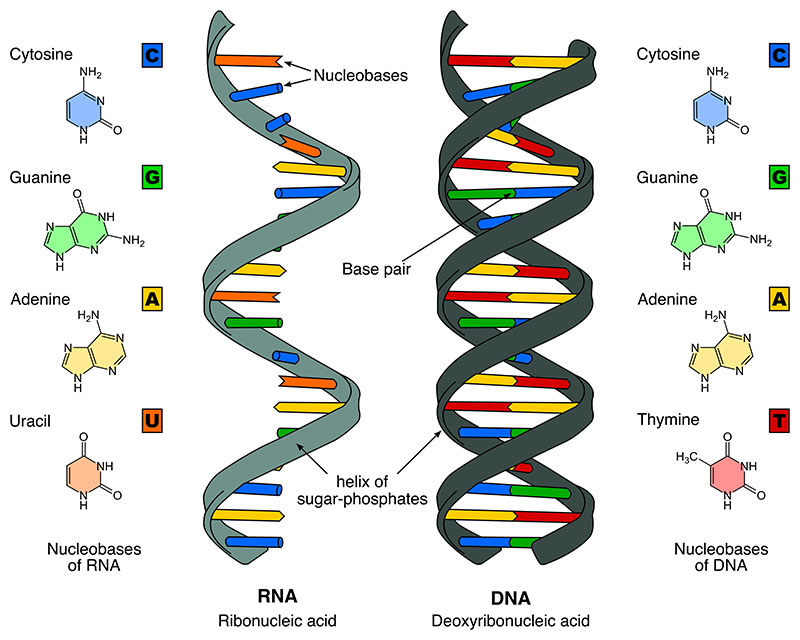RNA: The Versatile Molecule of Life
What is RNA?
RNA, or ribonucleic acid, is a essential biological molecule that plays a crucial role in various cellular processes. It is a polymeric molecule composed of nucleotides, each containing a ribose sugar, a phosphate group, and one of four nitrogenous bases: adenine (A), uracil (U), guanine (G), or cytosine (C). RNA is similar to DNA but contains uracil instead of thymine (T) and has a single-stranded structure.

Types of RNA
There are three main types of RNA, each with distinct functions in the cell:
Messenger RNA (mRNA)
Messenger RNA (mRNA) carries genetic information from DNA to the ribosomes, where it is translated into proteins. During transcription, the enzyme RNA polymerase synthesizes mRNA using one of the DNA strands as a template. The resulting mRNA molecule is complementary to the DNA template and contains codons that specify the amino acid sequence of the protein to be synthesized.
Transfer RNA (tRNA)
Transfer RNA (tRNA) molecules are responsible for delivering amino acids to the ribosomes during protein synthesis. Each tRNA molecule has an anticodon that is complementary to a specific codon on the mRNA. The tRNA binds to its corresponding amino acid and transports it to the ribosome, where it is incorporated into the growing polypeptide chain.
Ribosomal RNA (rRNA)
Ribosomal RNA (rRNA) is a component of the ribosomes, the cellular machinery responsible for protein synthesis. rRNA molecules, along with ribosomal proteins, form the structure of the ribosomes and catalyze the formation of peptide bonds between amino acids during translation.
RNA Synthesis and Processing
RNA synthesis, or transcription, is the process by which RNA is produced using DNA as a template. This process is carried out by the enzyme RNA polymerase, which binds to specific promoter regions on the DNA and initiates the synthesis of the complementary RNA strand. The resulting primary transcript, known as pre-mRNA in eukaryotes, undergoes several processing steps before becoming a mature mRNA molecule:
- 5' Capping: A modified guanine nucleotide, called a cap, is added to the 5' end of the pre-mRNA. This cap protects the mRNA from degradation and facilitates its translation.
- 3' Polyadenylation: A sequence of adenine nucleotides, known as a poly(A) tail, is added to the 3' end of the pre-mRNA. The poly(A) tail enhances mRNA stability and aids in its export from the nucleus to the cytoplasm.
- Splicing: In eukaryotes, the pre-mRNA contains both coding regions (exons) and non-coding regions (introns). During splicing, the introns are removed, and the exons are joined together to form a continuous coding sequence.
After processing, the mature mRNA is transported from the nucleus to the cytoplasm, where it serves as a template for protein synthesis.
RNA Functions
In addition to its roles in protein synthesis, RNA has several other important functions in the cell:
Catalytic RNA
Some RNA molecules, called ribozymes, possess catalytic activity and can catalyze chemical reactions. For example, the ribosome itself is a ribozyme, as the rRNA component catalyzes the formation of peptide bonds during protein synthesis. Other ribozymes include self-splicing introns and the RNA component of the enzyme telomerase.
Regulatory RNA
Non-coding RNA molecules, such as miRNAs (miRNAs) and long non-coding RNAs (lncRNAs), play essential roles in regulating gene expression. These RNA molecules can interact with mRNA, influencing its stability, translation, or degradation, thus fine-tuning protein production in the cell.
RNA Interference (RNAi)
RNA interference (RNAi) is a cellular mechanism that uses small RNA molecules, such as small interfering RNAs (siRNAs) and miRNAs, to silence gene expression. These small RNAs can bind to complementary mRNA sequences, triggering their degradation or preventing their translation. RNAi is a powerful tool for studying gene function and has potential applications in therapeutics.
RNA in Biotechnology and Medicine
The versatility and importance of RNA have made it a critical molecule in biotechnology and medicine. Some key applications include:
RNA Therapeutics
RNA-based therapeutics, such as siRNAs, antisense oligonucleotide, and mRNA vaccines, harness the power of RNA to treat or prevent diseases. These therapies can specifically target disease-causing genes or proteins, offering a precise and potentially safer alternative to traditional small-molecule drugs.
RNA Biomarkers
Changes in RNA expression levels can serve as biomarkers for various diseases, including cancer, neurodegenerative disorders, and infectious diseases. Analyzing RNA profiles can aid in early diagnosis, prognosis, and monitoring treatment response.
RNA-Based Diagnostics
RNA-based diagnostic tools, such as RT-PCR and RNA sequencing, are widely used for detecting and quantifying RNA in biological samples. These techniques are invaluable for diagnosing viral infections, characterizing gene expression patterns, and identifying disease-associated mutations.
Challenges and Future Perspectives
Despite the immense potential of RNA in biotechnology and medicine, several challenges need to be addressed. One major hurdle is the stability of RNA molecules, as they are prone to degradation by cellular enzymes. Developing efficient delivery systems for RNA therapeutics and ensuring their specificity and safety are also critical areas of research.
Future research will focus on expanding the applications of RNA-based technologies, such as developing more effective RNA therapeutics, refining RNA-based diagnostic tools, and exploring the role of non-coding RNAs in health and disease. Additionally, integrating RNA-based approaches with other emerging technologies, such as CRISPR-Cas systems and single-cell sequencing, will open up new avenues for fundamental research and clinical applications.
Further Reading
Cell Death & Disease, RNA-based therapeutics: an overview and prospectus
Frontiers in Bioengineering and Biotechnology, The Limitless Future of RNA Therapeutics
Molecules and Cells, RNA in Biology and Therapeutics
